To repurpose content, the process involves taking a high performing blog and using the content for a video, podcast, or slideshow. This is perhaps the most efficient way to breathe new life into your content strategy. The idea is simple. You might not know the type of content your audience wants to see or the way in which they wish to consume the information. However, to promote content effectively, you should strive to get your content into the hands of many different people. Converting an article into slides, a video, or a podcast is a great way to increase your reach to new audiences.
What are the benefits of content repurposing?
- Greater exposure: By repurposing your content, a wider audience will have the opportunity to enjoy and learn from your creative work. Some people might want to see the content as a SlideShare presentation since it’s quick and to the point, while others might like to see your content as a video tutorial. In this way, your content is reaching a wide network of people.
- Extends content reach over a period of time: Content repurposing maximizes the reach of your content. Someone who missed your blog post may come across your repurposed SlideShare highlighting the same core topic. In this way, publishing repurposed content pieces over a period of time helps extend content reach.
- Cross Promotion: If you have a well-planned content repurposing approach, you can build quality backlinks to promote other content presentations. By doing so, more organic traffic can be achieved through content repurposing.
- Better SEO and Authority: Publishing content on a single topic in a variety of places will boost your SEO and could help you rank higher on Google.
How do you find content for repurposing?
Finding content worth repurposing can be quite difficult, especially when you are running out of new ideas and concepts. Some of your past content properties may receive more shares organically, while others may not. So, it is very important to select content pieces that are easy to digest and are informative to the reader.
Here are a few types of content that can be repurposed:
Evergreen content
Evergreen content is content that remains relevant over a longer period of time. This type of content is based on topics that people will search for year after year. An example of this is seasonal content such as, "How to Decorate Your House for the Holidays." This type of content accumulates traffic over time and is great to repurpose.
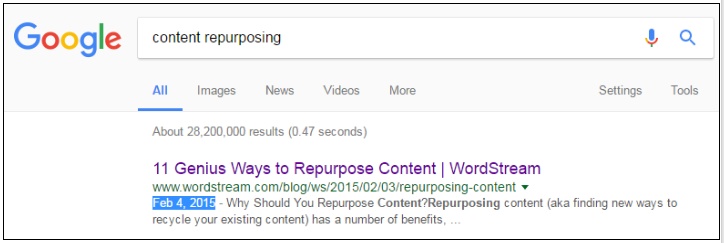
Example of evergreen content
Source: Google
The post by WordStream above shows a lot of opportunity in terms of content repurposing. WordStream could turn this particular piece of content into an infographic, a cheat sheet to capture more leads or an eBook. People will always be searching for "ways to repurpose content," so this content remains relevant over time.
Your most popular posts
Check your site’s analytics to choose the best performing blogs of the year or the month. These pages are great to repurpose because you already know that people are interested in the content, and you have the ability to create new opportunities for people to digest this information.
Content that needs to be updated
If your post needs to be updated with valuable data surrounding new trends, or the information in a particular blog post remains stale, this content is the perfect candidate for recycling. Quickly update your content and share across multiple platforms to improve the reach.
How can you repurpose your work?
With evergreen content and your top ranking content, your next step is to transform this content into an alternate format. If you have a blog post on a particular topic such as, “How to Hack User Experience Ranking Signals” you can turn this piece into a SlideShare presentation. From there, you can use your slides to create an infographic. You can even turn your post into a video or webinar if you think these formats would work. By taking these steps, you can revamp your old content and use different strategies to reach a multitude of audiences.
6 Great Tactics to Repurpose Content
1. Ultimate Website Launch Checklist (SlideShare Presentation): SlideShare presentations often rank high in search results. So by repurposing your blog post into a presentation, you are actually bringing your content in front of new audiences who may not have seen your content before. In the example below, the blog post "Ultimate Website Launch Checklist" was deemed both popular and informative. So, this particular blog was converted into a SlideShare presentation. In this format, the content becomes exciting and visually appealing. Click here to see how a blog post is repurposed as a SlideShare presentation to get more online visibility, authority, and traffic.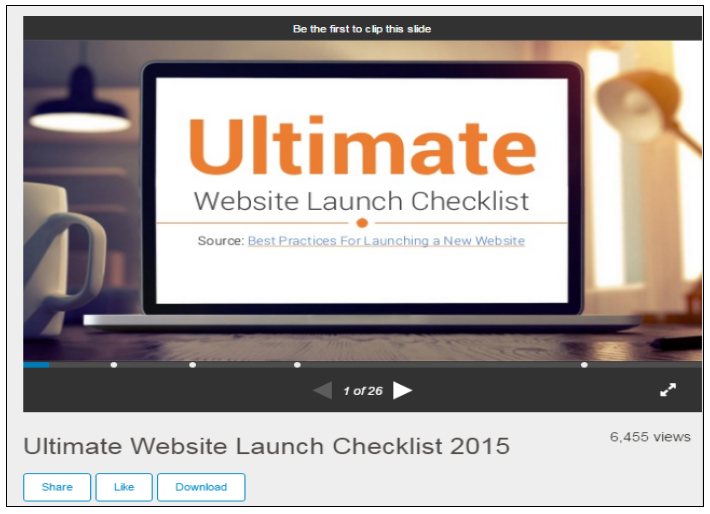
Example of repurposing a Blog Post to SlideShare Presentation
You can see just how easy it is to repurpose blog posts to SlideShare presentations while taking advantage of content you’ve already used to get more traffic, leads, and boost your online exposure.
The basic tools used to create presentations are:
• Slideshare
• Zoho
• Powerpoint
• Prezi
• AuthorStream
2. How to Succeed in Drug Discovery: Top 3 Business Challenges (Videos): A full-length ACS webinar on the “Future of Drug Discovery: Challenges, Risks, and Rewards” was broadcasted on October 20, 2014. The recording of this webinar was then repurposed in the form of a video and uploaded to YouTube. Creating this type of video is fairly straightforward. While preparing the webinar, they likely created an outline of the key points to cover the topic. This list served as the backbone for this particular video while outlining the main points to the audience.

Example of a Webinar repurposed to video
3. Facebook image sizes cheat sheet (Infographics): This cheat sheet infographic from Techwyse lists all the image dimensions for Facebook organic page posts, as well as ads so that you don’t have to waste time searching for the correct dimensions and image guidelines yourself. This infographic on Facebook image sizes is republished on Infographic Journal, including a link back to the original resource. The below figure shows the same.
Another example of an infographic republished on Infographic JournalSimilarly, "Microsoft Teams vs Slack -- A Detailed Look" is republished on LinkedIn with a link back to the original resource.

Example of an infographic republished on LinkedIn
By republishing on LinkedIn, you can reach a broader audience and start a conversation which helps to drive traffic to your profile and to your company page as well.
4. Grow Your Business with Rick Kranz (Podcasts): A study on podcasts can be explained with the help of the podcast by the OverGo Studio’s founder, Rick Kranz. He titled this Episode "Using Marketing Automation to Grow Sales." He reveals his best tips, strategies, and online marketing techniques for growing your business. To listen to the audio podcast, mouse over the title and click Play. Open iTunes to download and subscribe to podcasts.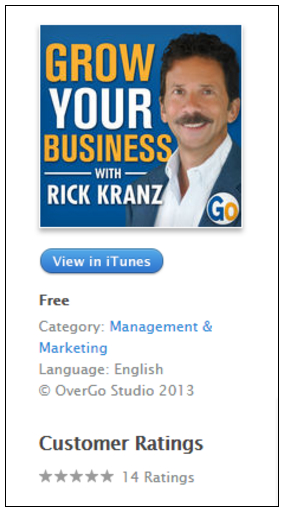
Example of a Podcast submitted into iTunes
You can use a video recording and submit this file to the following podcast databases:
iTunes Store
Micro Guide
Stitcher
Double Twist
Soundcloud
BluBrry
Click here to see the steps for submission of your podcast feed to iTunes, Stitcher, and Blackberry.
5. SEO Secrets Revealed By Industry Experts (eBook): A great option when looking to repurpose content, is to create an eBook. Here, the LinkedIn post on "SEO Secrets Revealed By Industry Experts" has a link to a free eBook which can be downloaded with ease.
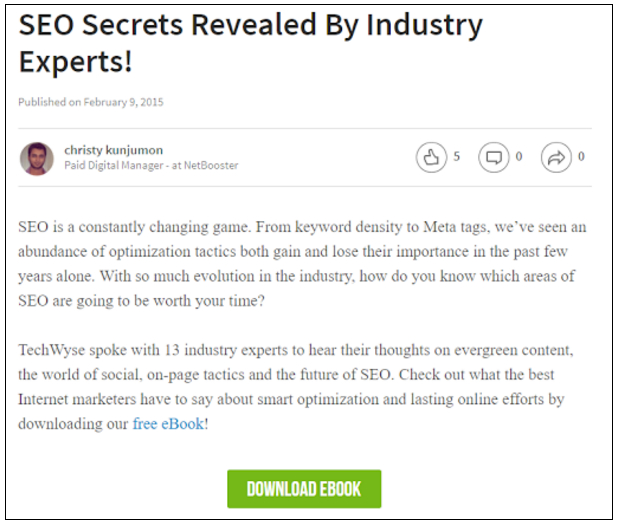
Example of a LinkedIn post linking to an eBook
6. Interview with Mark Traphagen (Interviews): Another great idea is to find an industry expert and conduct an interview. You can then publish the interview as a new compelling blog post or share it as a video. The process of conducting an interview is easy, just email your prospect two to three quick questions which will spark a great discussion and provide valuable content to your audience. For example, an interview with Mark Traphagen is repurposed in this blog post. The blog post is republished on LinkedIn, with a link taking you back to the original source.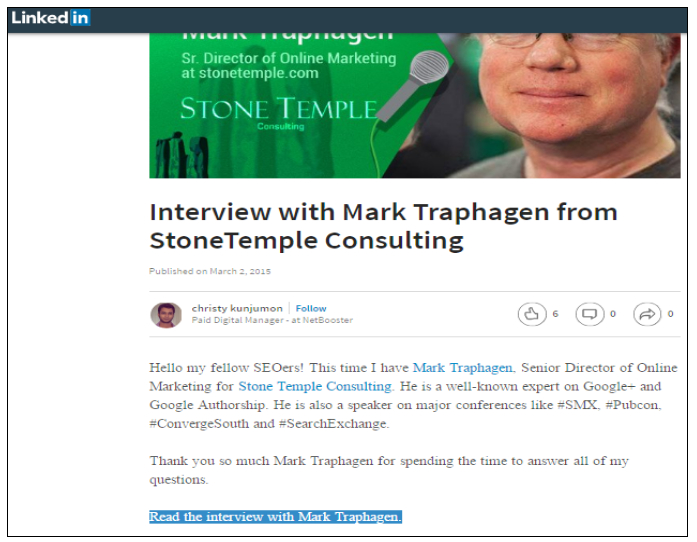
Example of an interview blog post republished on LinkedIn
These are the just 6 basic strategies that you can use to repurpose your content from a single idea. Repurposing your best content in this manner will allow you to reach different audiences with new ways to digest the information. Repurposing content is also a great way to save time and money throughout your content creation process. If your content consists of quality pieces and is distributed across multiple channels, then it will surely help to increase organic search traffic.
What are some creative ways you’ve repurposed content? Share your ideas and thoughts in the comments!







on
I’ve been looking for this information for a long time, thank you